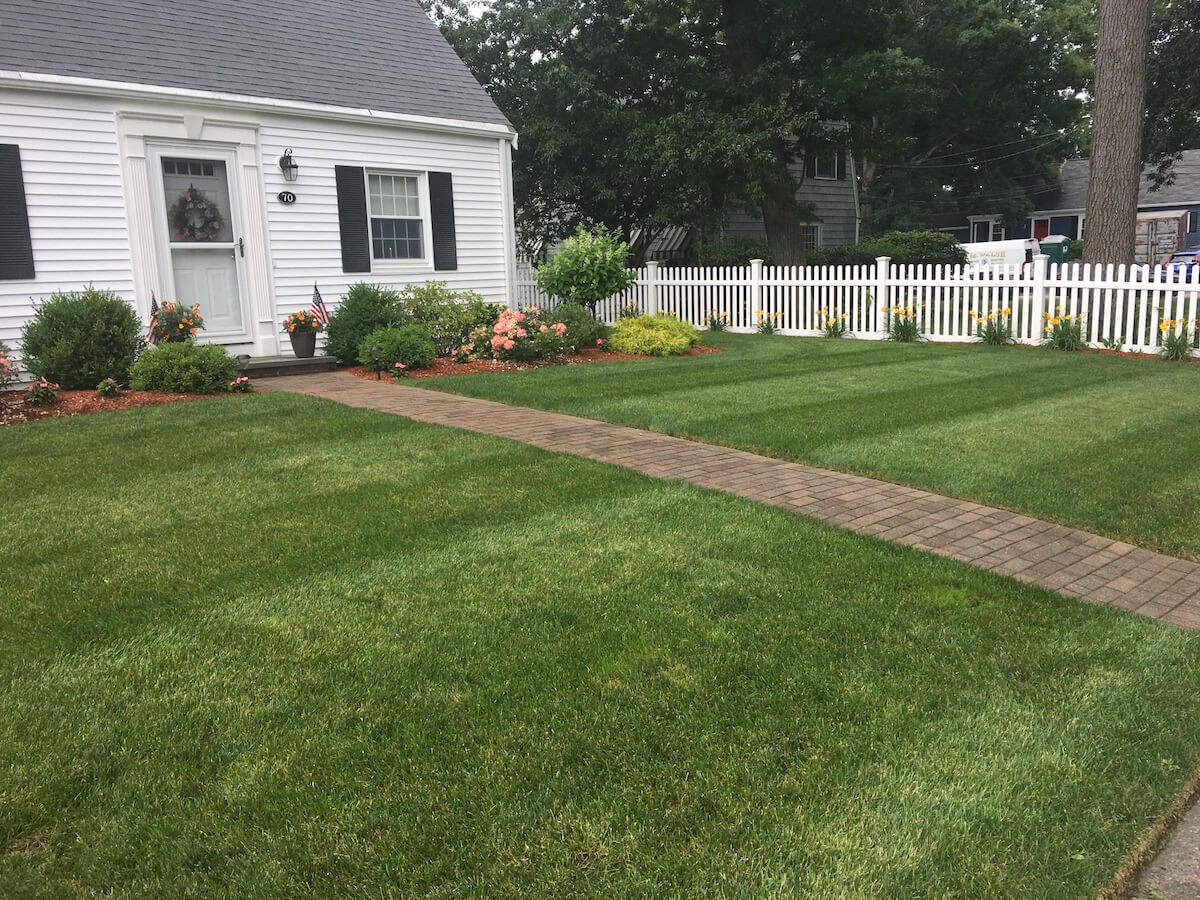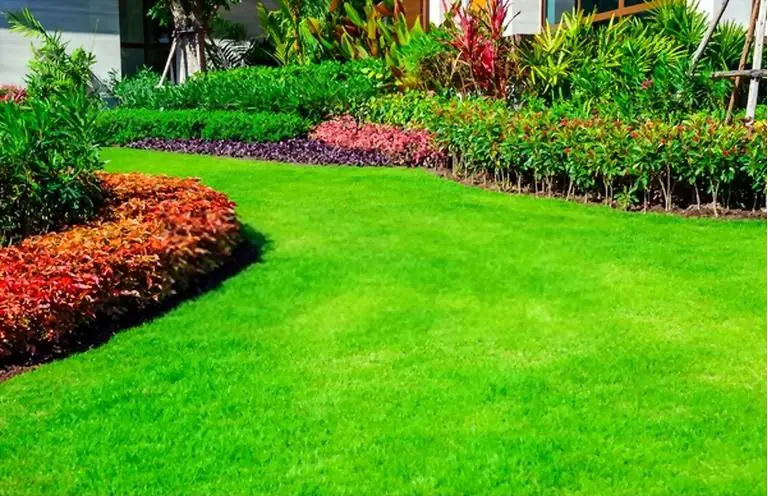Overseeding A Thin Lawn
Preparation is key to overseeding a thin lawn. The best time for overseeding is early fall. A soil-testing kit from your local county extension office can alert you to any nutrient deficiencies you may need to correct in your lawn’s soil.
To control weeds before overseeding, you can spray the entire lawn with a herbicide that controls broad-leaved weeds. If grassy weeds are the main problem, spray patches individually with a nonselective weed killer, such as glyphosate, or you’ll damage the lawn grass too. When spraying herbicides, carefully follow the directions on the product label, and wear protective clothing, including long pants, a long-sleeved shirt, socks, closed-toe shoes, gloves and safety goggles. Wait two to four weeks to allow the weed killers time to take effect.
Two days before overseeding, soak the lawn with water so the soil is moist to a depth of 6 to 8 inches. After a day or two, when the soil surface is sufficiently dry, remove the lawn thatch, which is the dead grass, moss and other plant debris that’s built up around the grass. Rake out the thatch vigorously or use a vertical mower or sod cutter to remove it. Spread nitrogen lawn fertilizer over the lawn at a rate of 1/2 pound per 1,000 square feet and lightly rake the fertilizer into any bare patches of soil. If a soil test indicates a potassium or phosphorus deficiency, apply these plant nutrients too at the rate stated in the test results.
Why Is Nitrogen Important For A Green Lawn
Grass cant grow without nitrogen. In fact, its the most important nutrient to support your lawn. Nitrogen works by encouraging new green growth above the soil line. For anyone who remembers middle school biology, this is where the photosynthesis takes place, which helps generate enough energy so that the roots grow healthy and the grass can ward off any pests or diseases.
Perhaps even more important for you and your lawn, nitrogen is also an essential component of chlorophyll, which is what the plants use to feed themselvesand also what gives them their beautiful green pigment. Without nitrogen and all of the things that it supports, you may notice grass blades that are shorter, brittle, dull in color, and more susceptible to stress and disease .
How Do You Get Grass To Spread
Is your grass growing fast, but it feels like something is missing? Is your lawn too sparse? Is your neighbors yard thick, lush, and beautiful? Have you grown the same variety? Do not panic many aspects could be the problem. These issues might relate to pests, shade as well as compaction. How about looking first into the issues mentioned above and solve them before opting for other things?
If the problem persists, then understand that the mowing techniques you are employing. Consider some tweaks to your way of mowing, and you will realize some differences in your lawn.
You May Like: Trugreen Lawn Care Cost
What Are Some Grass Growing Tips
Lawn Care To Prevent A Thin Lawn

If your lawn is thin due to nutrient deficiency, drought or poor mowing practices, improved care will prevent the problem from recurring. Apply nitrogen at a rate of 3/4 to 1 pound per 1,000 square feet two to four times per year at evenly spaced intervals during the growing season.
Signs of drought include wilting, blue-green or brown grass, and footprints that remain after walking on the lawn. Water dry lawns deeply so the soil is moist to a depth of 6 inches and irrigate regularly to keep the soil moist, but not soggy. Don’t remove more than one-third of the height of the grass when mowing and mow regularly to maintain it at a height of 2 1/2 to 3 1/2 inches.
References
Read Also: Who Makes Greenworks Lawn Mowers
Thicken Grass In A Shady Lawn
Only shade-tolerant grasses, such as red fescue and St. Augustinegrass , grow thick and full in a lawn that’s in shade for a significant portion of the day. If a tree or shrub canopy has grown over the lawn, prune the branches so that more sunlight reaches the grass. Wipe your pruning shears or saw with rubbing alcohol before and after pruning to avoid spreading pests and diseases.
Choose The Correct Grass For Your Property
Many grass varieties will only grow well when they receive enough sunlight. If you plant these varieties in a very shady backyard, you can expect a thin, unhappy-looking lawn. A better strategy if you have a shady garden is to do your research and choose a variety of grass that tolerates shade well. Turf varieties such as Sir Walter Buffalo will survive and thrive in shaded areas, whereas varieties such as Eureka Premium VG will not tolerate shade very well and must be grown in full sun. Choose your turf grass wisely and youll be a step ahead when it comes to creating a thicker lawn.
Recommended Reading: How To Treat Ant Hills In Lawn
Getting Started Creating A Beautiful Lawn
As the old saying goes, the first step in solving a problem is admitting there is one. Luckily, yard problems are usually pretty easy to identify. A visual inspection is often a good indicator that your lawn needs some help.
If your lawn lacks the thickness, vibrancy, and consistent colour it should have, several problems could be the cause. Some of these problems are simple fixes, while some may need more attention and care.
Check The Quality Of Your Soil
Some people just choose a fertilizer, apply it to their lawn, and then wonder why they arent getting results. The truth is that before you can properly fertilize the lawn, you have to know whats going on in the soil.
Soil testing is one of the best things you can do to encourage thick, green grass. The health of your lawn often depends on the pH of the soil. Soil pH is measured on a scale of 1 to 14. Seven is neutral. If the result is lower than 7, your soil is acidic. If its higher than 7, your solid is alkaline.
A soil test also determines what minerals and elements are missing so you know if you need to replace anything. Soil testing kits are available at most garden stores, and you can buy them online. You can also find testing meters that are inserted into the soil and immediately give you a pH reading.
Most soils in the Pacific Northwest and the eastern U.S. are naturally acidic. A lot of diseases and weeds prefer acidic soil, so its an important thing to identify and correct if you want a healthy, thick green lawn.
To reduce the acidity of acidic soil, adding lime is recommended. This is a long process, though, and not something you can fix overnight. The best time to start the process is in the fall to improve the problem before summer, but you can do it at any time of the year. As a bonus, lime also contains magnesium and calcium, which can also improve lawn growth.
Once youve made the necessary adjustments, youre ready to move onto the next step.
Don’t Miss: Lowes Lapping Compound
How To Make Your Grass Greener And Thicker
I bet greener, thicker, and lusher are the top three words that any homeowners note for their lawn goals. The good news is, its not difficult to transform from a lackluster lawn into lusher, thicker, and healthier, as long as you follow these 6 steps.
They are divided into two processes. First off, making your lawn thicker and next is to maintain it. Without further ado, lets get into it!
Remove Any Weeds Dead Plants & Other Debris
Before beginning any lawn re-growth maintenance work, you need to make sure your area is clear of all weeds, dead or dying plants, and other debris that would get in the way.
When removing weeds by hand, make sure you pull out the entire root of the plant, or it will just grow back and spread. Using a weeding tool can help you get down to the robust and sturdy weed roots.
When removing weeds with a weed killer, make sure you carefully follow the instructions to prevent damage to any other plants.
Read Also: Rolled Grass Price
How To Fix A Thinning Lawn
Thinareas in the lawn aren’t just unsightly, they can also lead to worseproblems like weed invasion or loss of topsoil from erosion. Athinning lawn is systematic of other problems in the landscape.Address the problem and then choose a method to fix the thin area toavoid further lawn problems in the future.
CommonCauses of Thinning Lawns
Culturalproblems are the most common cause of thin lawns, which you canusually remedy yourself during lawn repair. If you suspect pest ordisease are at the root of the lawn problem, then having professionaltreatment for the culprit prior to repairing the lawn may benecessary.
ShadeIssues
Lawnsin shady areas tend to be most prone to thinning. Heavy tree coversor shade from nearby structures are usually the culprit. Although youcan have trees removed or thinned out, choosing a lawn grass thatthrives in shadier conditions offers another solution. St. Augustineand zoysia grasses provide a warm season option for shade, while agood cool season option is one of the many fescue grasses thatare available.
DroughtStress
Grassneeds water to grow lush and thick. As a general rule of thumb,provide 1 to 1 1/2 inches of water weekly. Thatch buildup andcompacted soil can also reduce the amount of water that reaches grassroots. Thatch removal and soil aeration will remedy the problem somoisture can once again soak into the soil.
NutrientDeficiency
Methodsto Repair a Thin Lawn
Overseeding
SodInstallation
Simple Steps To A Thicker Lusher Lawn Lush Lawn Lawn

As the new grass grows in, it will fill in the areas between the existing grasses and help your lawn grow in thick and full. Cut no more than a third the height of the grass, and bag your clippings on the first mow .
Healthy summer lawn in 4 easy steps with lawn lush recipe. 18) there are two main types of aerator available, spike aerators and plug aerators.
How to grow a lush green and thick lawn this summer in. Adding fresh grass seed to your lawn is never a bad thing.
How to make bermuda grass thicker tips for solving the. Advantages of thicker and fuller lawns.
How to make your lawn thicker and greener tips for. Aeration is one of the best ways to increase the flow of nutrients, water, and air into the root zone of the grass and make.
How to turn yellow grass green fast tips for keeping your. As the new grass grows in, it will fill in the areas between the existing grasses and help your lawn grow in thick and full.
How to get a thicker lawn and keep it lawn and. Cut no more than a third the height of the grass, and bag your clippings on the first mow (you can mulch them into your.
How to get a thicker lawn and keep it lawn fertilizer. For a small to medium sized yard, begin with about one pound of liquid lawn fertilizer in a large bucket.
How to get a thicker lawn and keep it lush lawn lawn. Four steps to get a thicker lawn 1.
How to grow greener grass grass lawn care tips lawn. Going over your lawn in different directions will help the grass to.
Read Also: Does Lime Kill Moles
Next Steps You Can Take To Make Grass Thicker And Fuller
There are a few core lawn maintenance projects that you can complete to improve the condition of your lawn.
Anyone asking how to make grass thicker and fuller probably has a yard that would benefit from these three projects, and you can do all three at the same time in a single weekend.
Early in the fall is the best time to tackle these projects, though spring can work too.
What To Do When Youve Got Drainage And Soil Issues
Drainage issues are generally pretty easy to spot. They include things like soggy yards, puddles that just wont go away, or patches of grass that are growing thicker and faster than surrounding areas. If youve got drainage issues, there are some things you can do to address them, including having a yard that is built and designed correctly.
Don’t Miss: When Can I Mow After Trugreen Treatment
Add The Right Fertilizer
Just like all plants, your lawn needs to be fed. Rainfall and watering leach away necessary nutrients, so to make sure your lawn has everything it needs, regular fertilization throughout the summer helps promote healthy growth.
Look for a fertilizer that has both slow and immediate release nitrogen. The slow-release type feeds your lawn over about three months while the immediate release can be used by your lawn right away.
The Next Phase
Once youve made the necessary changes to your soil and have allowed the overseeding to grow in, your lawn should begin looking thicker and greener. Now that you have the lawn that you wanted, you have to take care of it to make sure it stays that way.
How To Make Grass Thicker And Fuller
So, how can you make your lawn grass thicker and fuller? Well, its not something that you can do overnight. All you need is a proper lawn care routine and some patience.
Lets go through some of the lawn maintenance activities that are sure to enhance the growth and thickness of your lawn grass when done properly.
You May Like: Core Aerator Rental Lowes
Be Proactive To Make Your Lawn Thicker
There are a lot of things going on out there in your yard that can keep your grass from reaching its thick, healthy potential.
Weeds. Bugs. Disease.
Pros know how to diagnose lawn care problems before you even notice anythings wrong.
When our lawn care technicians are out there spreading seed, or applying fertilizer, or treating for weeds, theyre looking at your lawns total health.
They might notice signs of Japanese beetles, grubs, or lawn diseases.
Our technicians are trained professionals, so they catch things early before they turn into worrisome and expensive problems that can keep your grass from being as thick as possible.
How To Make Grass Grow Green And Healthy
This brings us to our next consideration: when and how often to water grass for optimal greenery?
The advice that were about to give you should be taken as just that, advice. One of the best things that you can do for your lawn is to get to know it.
Take some time observing how it looks each day, in the morning and in the evening. Try to become aware of all of the different elements that affect it and how these fluctuate throughout the day. The better understanding you have of your lawn and your specific microclimate, the better youll be able to take care of it.
Then, you can consider the following :
- Watering in the morning is the best because temperatures are cooler and winds are normally calmer. If possible, water before 10 a.m. so that all of the moisture can be absorbed before the heat of the day kicks in and evaporates all the water away.
- If you have no option but to water in the evening, try to do so before nightfall .
- When watering, you want the top six to eight inches of soil to be wetwhich equates to around one inch of water per week. This can be done as a single watering or two waterings this every week.
Recommended Reading: Remove Violets From Lawn
Aerate And Overseed Your Lawn When Needed
Water and nutrients need to reach lawn roots in order to lead to thicker and greener grass. Over time, lawns can become compact, whether its from traffic or harsh weather, limiting this easy access of water and nutrients.
The solution is annual aeration. This practice breaks up the soil and enables the lawn to breath. Also, those small holes aeration creates can provide the perfect access for overseeding in thin, bare areas. Aeration and overseeding are key elements that shouldnt be forgotten on the journey to greener, thicker grass.
Thicken It Out With Overseeding

If your lawn is sporting thin, bare patches, its time to overseed the lawn. This process simply involves sowing extra grass seed into the existing lawn to create a thicker and lusher look and feel. You can also lay small strips of instant turf in the bare areas to instantly improve the thickness of your lawn. Either way you do it, make sure you are using the same type of grass seed or turf that you already have in your lawn. This will help avoid areas of difference in the lawn.
Also Check: How Much Is Trugreen Service
What Causes A Thin Lawn
A thin, sparse-looking lawn can be caused by a wide variety of factors. These include:
- Improper mowing practices
- Damage from weather extremes such as drought
- Compaction
- Too much shade
- Damage from wear and tear
The first step is to determine which factor is causing problems in your lawn. It may be one or a combination of a few factors which are making your lawn thin.
Signs of drought include grass wilting and browning off, and leaving footprints when you walk on the lawn. Nutrient deficiencies can be determined by conducting a soil test on your lawn. Compacted soil will feel hard, and the grass will have shallow, thin roots as they are unable to penetrate the hard soil. Diseases or infestations will show up in brown grass, bare patches or spots on the grass.
